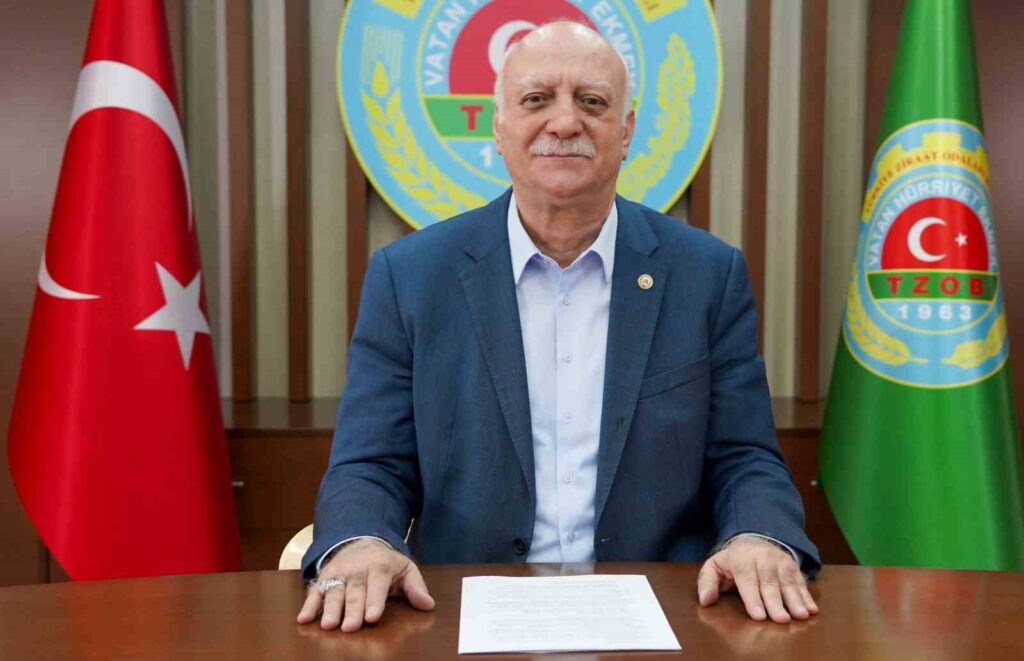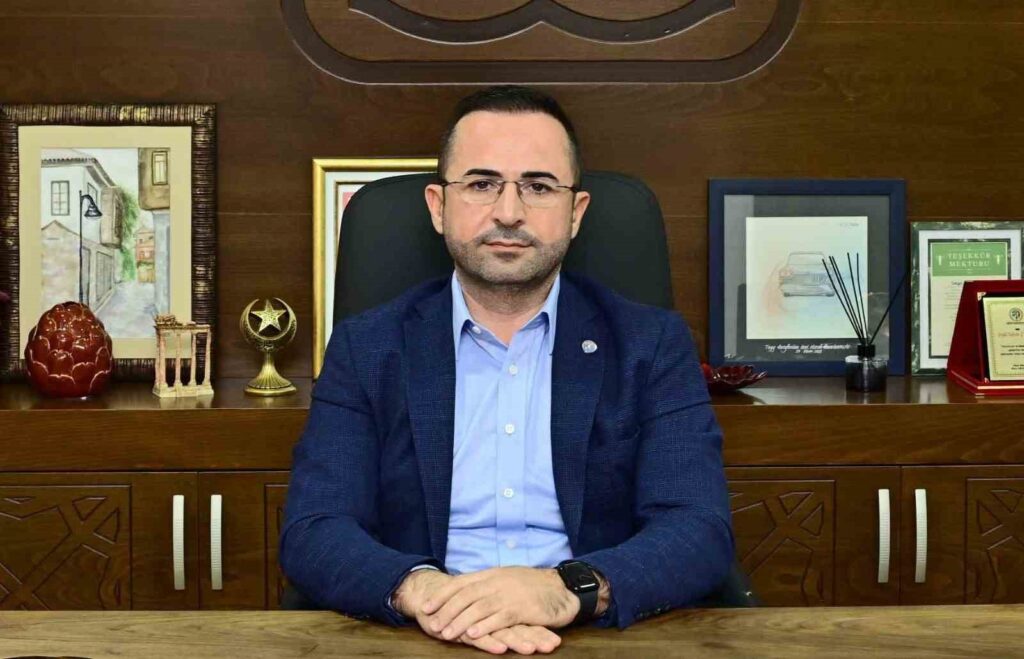It is expected to contribute 426 million worth of leather to the economy during the Feast of the Sacrifice
The President of the Union of Chambers of Agriculture of Turkey (TZOB), Şemsi Bayraktar, stated that ‘The estimated value of the leather to be contributed to the economy during the Feast of Sacrifice will remain around 426 million 400 thousand Turkish liras.’ President of TZOB, Şemsi Bayraktar, mentioned the upcoming Feast of Sacrifice…

The President of the Union of Turkish Agricultural Chambers (TZOB), Şemsi Bayraktar, stated that ‘The estimated value of the leather to be contributed to the economy during Eid al-Adha will remain around 426 million 400 thousand Turkish Liras.’ Prior to Eid al-Adha, TZOB President Şemsi Bayraktar made evaluations regarding sacrificial animal prices. Pointing out that sacrificial animal prices show more variability compared to previous years, Bayraktar expressed that the changes in meat prices confuse citizens who intend to buy sacrificial animals. Reminding of the sacrificial animal numbers announced by the Ministry of Agriculture and Forestry in the past years, Bayraktar stated, ‘Due to the decrease in purchasing power in our country and the significant increases in sacrificial animal prices, we estimate that there will be at least a 20% decrease in large animal slaughters and about 10% decrease in small animal slaughters compared to last year in this year. Taking into account the recent years’ sacrificial sales, we anticipate that approximately 680 thousand large animals and 2 million 500 thousand small animals, totaling 3 million 180 thousand sacrificial animals, will be slaughtered this year.’
Regarding the live weight price of sacrificial animals, Bayraktar mentioned that ‘According to the data we received from our agricultural chambers, it is observed that the average prices in our country will range between 75 thousand Turkish Liras and 250 thousand Turkish Liras per large animal, and between 8 thousand Turkish Liras and 25 thousand Turkish Liras per small animal. We estimate that the live weight price will be between 200 Turkish Liras and 300 Turkish Liras per kilogram for large animals, and between 180 Turkish Liras and 300 Turkish Liras per kilogram for small animals.’ Bayraktar continued his speech by stating, ‘Looking at the country’s average, it is seen that the live kilogram price of large animals is 248 Turkish Liras, and the live kilogram prices of small animals are 244 Turkish Liras. Prices have increased by 68.8% for large animals and 88.4% for small animals compared to last year. The average price per kilogram increased from 147 Turkish Liras to 248 Turkish Liras for large animals, and from 130 Turkish Liras to 244 Turkish Liras for small animals. The live kilogram prices for large animals vary between 250 Turkish Liras and 300 Turkish Liras on the European side of Istanbul, between 240 Turkish Liras and 300 Turkish Liras on the Anatolian side, between 230 Turkish Liras and 280 Turkish Liras in Ankara, and between 250 Turkish Liras and 270 Turkish Liras in Izmir. The prices for small animals range between 240 Turkish Liras and 300 Turkish Liras in Istanbul on the European side, between 230 Turkish Liras and 300 Turkish Liras on the Anatolian side, between 240 Turkish Liras and 280 Turkish Liras in Ankara, and between 250 Turkish Liras and 300 Turkish Liras in Izmir.’
Bayraktar, evaluating the share prices of sacrificial animals, stated, ‘In some provinces, the share prices per person in share sales are between 22 thousand Turkish Liras and 35 thousand Turkish Liras in Istanbul, between 20 thousand Turkish Liras and 32 thousand Turkish Liras in Ankara, between 18 thousand Turkish Liras and 30 thousand Turkish Liras in Izmir and Bursa, between 20 thousand Turkish Liras and 25 thousand Turkish Liras in Kahramanmaraş, between 20 thousand Turkish Liras and 30 thousand Turkish Liras in Erzurum, Sakarya, and Malatya, and between 18 thousand Turkish Liras and 25 thousand Turkish Liras in Antalya, Karaman, and Kastamonu. These prices may vary according to demand as the holiday approaches.’ Highlighting the widening price gap in slaughter fees paid through proxies, Bayraktar noted, ‘In the past, the fees for proxies by foundations and associations domestically and internationally were almost the same, but this gap has been widening for the last 3 years, reaching up to 173% in 2024. Keeping the international prices of foundations and associations lower than the domestic prices leads many citizens to turn to those places thinking they are cheaper. This negatively affects the sales of our breeders in the domestic market. We are always in support of every penny of aid to needy Muslims both domestically and internationally. However, we must also remember that if we slaughter the sacrificial animals domestically and send the obtained meat to Muslims abroad through the cold chain, we will protect our producers and animal husbandry.’
Bayraktar listed the reasons for the rise in sacrificial animal prices, stating, ‘The decrease in the number of animals taken for fattening due to the slaughter of breeding animals in the past period increased meat prices. The average carcass price for cattle, which was 239 Turkish Liras last year, increased by 45.9% this year to 348 Turkish Liras, and the carcass price for sheep, which was 345 Turkish Liras, increased by 89.8% to 408 Turkish Liras. On the other hand, the increases in expenses such as feed, labor, veterinary services, medicine, electricity, transportation, and similar expenses alongside high inflation also influenced the increase in sacrificial animal prices. While the gross minimum wage paid to an employee in our breeders’ businesses was 10,080 Turkish Liras last year, it increased to around 20,020 Turkish Liras this year, with an approximately 100% increase. The fattening feed they bought for 7,230 Turkish Liras per ton last year increased by 41% to 10,188 Turkish Liras this year, and the dry clover they bought for 5,746 Turkish Liras increased by 24.5% to 7,153 Turkish Liras. The price per kilowatt-hour of electricity used in their businesses increased from 214 Turkish Liras last year to 250 Turkish Liras this year, a 20% increase. Diesel prices increased by 109% from 20 Turkish Liras to 41 Turkish Liras compared to last year. The transportation vehicle that cost 28,000 Turkish Liras from Kars to Ankara last year now costs 47,000 Turkish Liras, the vehicle going to Istanbul for 38,000 Turkish Liras now costs 58,000 Turkish Liras, and the vehicle going to Bursa and Izmir for 40,000 Turkish Liras now costs 60,000 Turkish Liras.’ Referring to the rental prices of tents at animal sales places, Bayraktar said, ‘Despite our annual calls to municipalities not to charge high fees for sacrificial tents, unfortunately, this high-price practice continues. Sellers pay tent rents ranging from 12,000 Turkish Liras to 25,000 Turkish Liras in Ankara for the 15 days they stay, from 25,000 Turkish Liras to 50,000 Turkish Liras in Bursa, from 25,000 Turkish Liras to 65,000 Turkish Liras in Izmir, and from 50,000 Turkish Liras to 120,000 Turkish Liras in Istanbul. Mayors should show sensitivity on this issue.’
Bayraktar continued his speech by stating, ‘Considering that the live kilogram price of a large animal with an average weight of 400 kilograms will be around 248 Turkish Liras, the money to be paid for approximately 680 thousand large animals to be slaughtered during the holiday will exceed 67 billion 545 million Turkish Liras. With an estimated average price of 15,900 Turkish Liras for a small animal, the money to be paid for approximately 2 million 500 thousand small animals to be slaughtered will be 39 billion 750 million Turkish Liras. In total, we estimate that our people will pay close to 107 billion 300 million Turkish Liras for around 3 million 200 thousand sacrificial animals to be slaughtered.’
Bayraktar stated, ‘It is estimated that the economic value of the sacrificial animal skins to be contributed to the economy during Eid al-Adha will be around 426 million 400 thousand Turkish Liras.’ Regarding the prices of sacrificial animal skins planned to be contributed to the economy, Bayraktar stated, ‘The standard cut and salted fresh sheepskin is sold for approximately 50 Turkish Liras each. When it is calculated that an estimated 2 million 500 thousand small animals will be slaughtered, the economic value of the skins of small animals will reach approximately 125 million Turkish Liras. Additionally, from an average 400-kilogram bovine, about 30 kilograms of skin can be obtained. Considering that the kilogram price of properly obtained and salted bovine skin is 20 Turkish Liras, the value of the skin to be obtained from the slaughter of 680 thousand large animals will reach 408 million Turkish Liras. If the standards are adhered to, an estimated total of approximately 533 million Turkish Liras in skin income will be obtained from sacrificial animals. However, due to the fact that sacrificial animals are slaughtered by unskilled individuals in many places, there is a significant economic loss in the skins. We estimate that this loss is around 20%, resulting in a total loss of around 106 million 600 thousand Turkish Liras. Therefore, due to the losses, it is expected that the estimated value of the skins to be contributed to the economy during Eid al-Adha will remain around 426 million 400 thousand Turkish Liras.’ Evaluating the fees planned to be paid to butchers, Bayraktar noted, ‘Butchers charge between 3,000 Turkish Liras and 5,000 Turkish Liras for only slaughtering, skinning, and quartering a large animal, between 5,000 Turkish Liras and 10,000 Turkish Liras for detailed cutting, and between 500 Turkish Liras and 1,000 Turkish Liras for small animals. With the estimation that approximately half of the large animals will be slaughtered by butchers for around 4,000 Turkish Liras, the amount to be paid to butchers for 340 thousand large animals will be 1 billion 400 million Turkish Liras. Similarly, with the calculation that approximately half of the small animals will be slaughtered by butchers for an average fee of 750 Turkish Liras, the amount to be paid to butchers for 1 million 250 thousand small animals will be 937.5 million Turkish Liras. Accordingly, the total amount to be paid to butchers will approach an estimated 2.3 billion Turkish Liras.’







